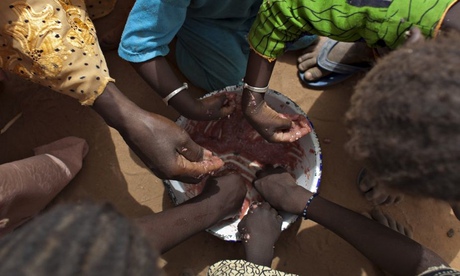
It’s been called “disaster overload” – major crises in Syria, Iraq, South Sudan, the Central African Republic (CAR) and the Philippines have left the United Nations’ humanitarian response system reeling. But as media attention gravitates toward the major crises, there’s been little thought to the long tail of the humanitarian system.
Chad, one of the poorest countries in Africa, is now facing two separate refugee crises: a long-running crisis in the east, where refugees from Darfur began arriving more than ten years ago and arrivals from the conflict-torn CAR in the south. Worse, instability in CAR has cut off the main logistics corridor used to bring assistance to the country. “Chad is landlocked, all resources must come through Cameroon, which makes everything more expensive,” explains Aminata Gueye, the UN High Commission for Refugees (UNHCR)’s representative in Chad. The agency is struggling to cope, having raised just 25% of its needs for 2014.
The World Food Programme (WFP) has done slightly better, raising 30.9% of funds needed for its Chad operation. Yet sharply rising transport cuts have forced the agency to severely cut back on food distributed to refugees, with the standard ration now standing at a mere 850 calories per person per day. “The current ration level is very low,” says Caroline Wilkinson, a nutritionist at UNHCR working on Chad. “For the children it’s probably ok, but for a working adult it’s an extreme value of caloric intake.”
And it isn’t just Chad. From Mauritania to Somalia, food insecurity is chronic and widespread. Fundraising in the region appears particularly problematic. According to the Office for the Coordination of Humanitarian Affairs (Ocha), in Mali, just 37% of the $568m needed for humanitarian operations in 2014 has been funded. In Burkina Faso, 34%, in Somalia, where famine looms, it’s 32%. And a $1bn protracted WFP operation in Niger has attracted just 11% of the funds needed.
Given a funding architecture where the bulk of humanitarian donations are earmarked for use in a specific emergency, second-tier crises like the one in South Sudan face major obstacles to fundraising and third-tier crises like those in Chad often don’t get any direct funding. “We have plenty of operations that attract no earmarked funds at all,” says Alex Mundt, senior donor relations officer for the UNHCR. In those cases, the agency allocates non-earmarked contributions, typically from private donors, or “loosely earmarked” funds from donor governments directed at a broad region, rather than a specific place or activity. For the WFP, just 11% of donations come with no strings attached.
In parts of the voluntary sector, unrestricted donations are common. John Longhurst, director of communications at Canadian Foodgrains Bank says: “We’re fortunate to have a church-based support network that is used to just sending money each year for use where it’s needed most.” That flexibility helps the charity to send funds to places that aren’t making headlines, says Longhurst, although he admits that “it always helps if there’s more information about these kinds of crisis on the news”.
It’s no great mystery who wins out in the scramble for that precious media attention: major, sudden disasters in countries that have large diasporas, like the Philippines, or dramatic conflicts in strategically significant places, like Gaza. It’s easy to lose sight of the fact that most humanitarian relief operations are nothing like that. The typical UNHCR or WFP operation comes in response to a situation that develops slowly or drags on for decades: things that, virtually by definition, aren’t news. The chronic hunger that has resulted from conflict and land degradation in Uganda’s Karamoja region or living conditions in western Algeria’s now five-decade old refugee camps can hardly compete for an editor’s attention with the drama of war in Syria.
While global humanitarian spending is rising, demand for humanitarian services is rising faster. Yet some question whether it is true that more demands are being placed on a static pot of money. The alternative interpretation is that the high-profile crises raise the profile of the humanitarian enterprise in general, helping grow the pot. “With these high-profile crises, humanitarians are being given a seat at the table in policy discussions,” UNHCR’s Mundt says. “As the needs have grown, policymakers see that they have an obligation.”
In the meantime, the rush of crises is amplifying the need for unearmarked funding. Loosening earmarks or forgoing them altogether is recognised as one of the principles of good humanitarian donorship, a voluntary framework that, in principle, all major donors adhere to. Yet, less than 1% of the US’s standard contribution to the WFP is unearmarked, for instance, as opposed to more than 80% of Sweden’s. This needs to change, but bureaucratic inertia is a major obstacle to improved response to these invisible crises.
Read more stories like this:
• The F-word: when can we call what’s happening in South Sudan a famine?
• An African outlook on improving nutrition on the continent
• Which 7 countries are most committed to ending hunger?
• Advertisment feature: The MDGs: what’s breastfeeding got to do with it?
Join our community of development professionals and humanitarians. Follow @GuardianGDP on Twitter.









